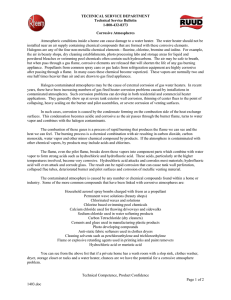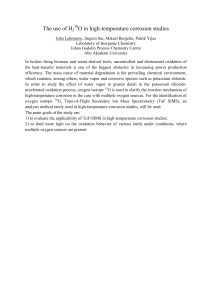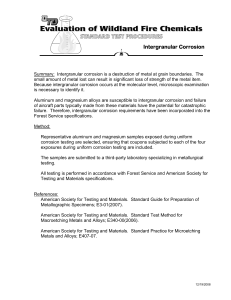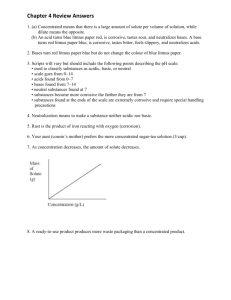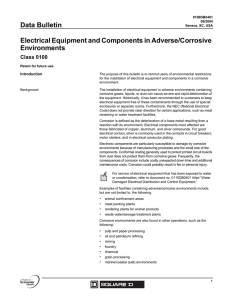Document 11456039
advertisement
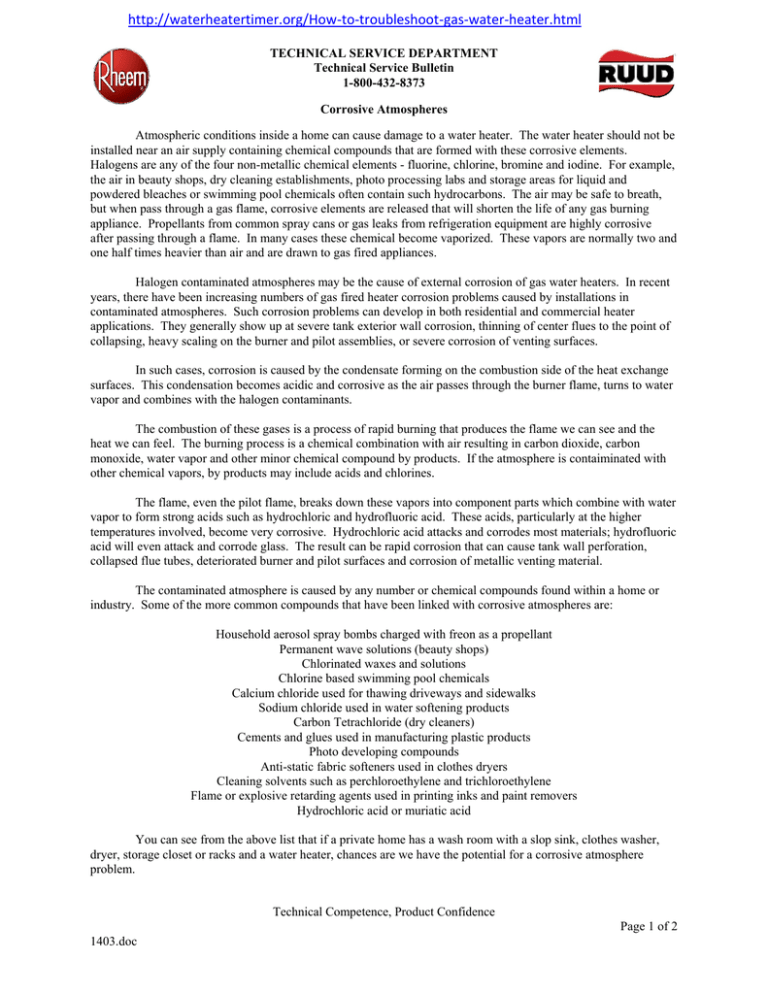
http://waterheatertimer.org/How-to-troubleshoot-gas-water-heater.html TECHNICAL SERVICE DEPARTMENT Technical Service Bulletin 1-800-432-8373 Corrosive Atmospheres Atmospheric conditions inside a home can cause damage to a water heater. The water heater should not be installed near an air supply containing chemical compounds that are formed with these corrosive elements. Halogens are any of the four non-metallic chemical elements - fluorine, chlorine, bromine and iodine. For example, the air in beauty shops, dry cleaning establishments, photo processing labs and storage areas for liquid and powdered bleaches or swimming pool chemicals often contain such hydrocarbons. The air may be safe to breath, but when pass through a gas flame, corrosive elements are released that will shorten the life of any gas burning appliance. Propellants from common spray cans or gas leaks from refrigeration equipment are highly corrosive after passing through a flame. In many cases these chemical become vaporized. These vapors are normally two and one half times heavier than air and are drawn to gas fired appliances. Halogen contaminated atmospheres may be the cause of external corrosion of gas water heaters. In recent years, there have been increasing numbers of gas fired heater corrosion problems caused by installations in contaminated atmospheres. Such corrosion problems can develop in both residential and commercial heater applications. They generally show up at severe tank exterior wall corrosion, thinning of center flues to the point of collapsing, heavy scaling on the burner and pilot assemblies, or severe corrosion of venting surfaces. In such cases, corrosion is caused by the condensate forming on the combustion side of the heat exchange surfaces. This condensation becomes acidic and corrosive as the air passes through the burner flame, turns to water vapor and combines with the halogen contaminants. The combustion of these gases is a process of rapid burning that produces the flame we can see and the heat we can feel. The burning process is a chemical combination with air resulting in carbon dioxide, carbon monoxide, water vapor and other minor chemical compound by products. If the atmosphere is contaiminated with other chemical vapors, by products may include acids and chlorines. The flame, even the pilot flame, breaks down these vapors into component parts which combine with water vapor to form strong acids such as hydrochloric and hydrofluoric acid. These acids, particularly at the higher temperatures involved, become very corrosive. Hydrochloric acid attacks and corrodes most materials; hydrofluoric acid will even attack and corrode glass. The result can be rapid corrosion that can cause tank wall perforation, collapsed flue tubes, deteriorated burner and pilot surfaces and corrosion of metallic venting material. The contaminated atmosphere is caused by any number or chemical compounds found within a home or industry. Some of the more common compounds that have been linked with corrosive atmospheres are: Household aerosol spray bombs charged with freon as a propellant Permanent wave solutions (beauty shops) Chlorinated waxes and solutions Chlorine based swimming pool chemicals Calcium chloride used for thawing driveways and sidewalks Sodium chloride used in water softening products Carbon Tetrachloride (dry cleaners) Cements and glues used in manufacturing plastic products Photo developing compounds Anti-static fabric softeners used in clothes dryers Cleaning solvents such as perchloroethylene and trichloroethylene Flame or explosive retarding agents used in printing inks and paint removers Hydrochloric acid or muriatic acid You can see from the above list that if a private home has a wash room with a slop sink, clothes washer, dryer, storage closet or racks and a water heater, chances are we have the potential for a corrosive atmosphere problem. Technical Competence, Product Confidence Page 1 of 2 1403.doc TECHNICAL SERVICE DEPARTMENT Technical Service Bulletin 1-800-432-8373 Corrosive Atmospheres There is no simple way to solve the problem of contaminated atmospheres. Obviously, if the source can be located and removed, the problem will be solved. The breakdown of halogneated hydrocarbons in the presence of high temperatures and water vapor is a proven cause of premature gas water heater failure. The proper selection and placement of water heating equipment probably offers the best solution to the problem. A gas water heater should be isolated as far as possible from regular exposure to chemical contaminants. If this is not possible, then a fresh, uncontaminated air source from outside the building must be brought in for heater combustion. Here is a simple test that can be used in the field to detect the presence of chlorides in the corrosion residue. Place one teaspoonful (5 grams) of the corrosion product in one cup (25 to 50 cc) of distilled water. Add a few drops of silver nitrate to the solution. If the solution remains clear, halogens are not present. Excessive condensation could be the problem causing corrosion and flaking. If the solution turns cloudy, chlorinated hydrocarbons are suspect and the source of the contamination should be determined. If the source of the contamination is not apparent, some investigators use industrial type halogen leak detectors. This type of instrument is sensitive to 1/10th parts per million, an amount capable of producing corrosion. Technical Competence, Product Confidence Page 2 of 2 1403.doc
